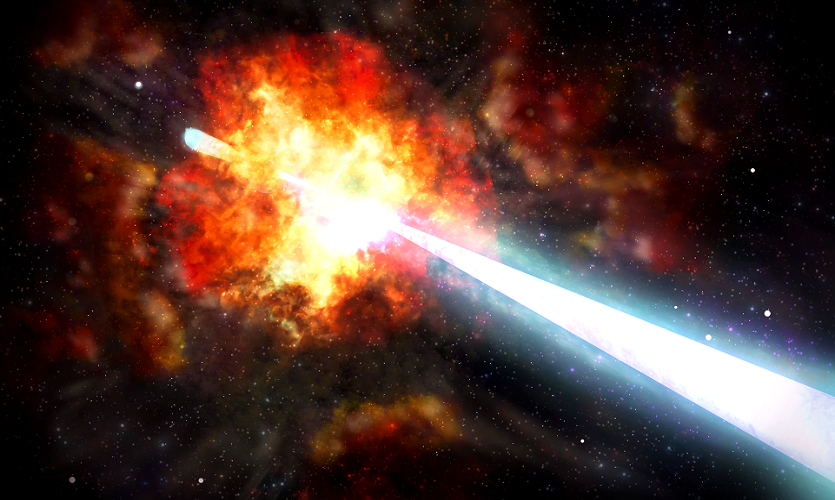Cosmic explosion is brightest of all time

An explosion so massive it produced the same energy in minutes as the Sun in its entire lifetime, has been observed by astronomers.
The fireball was spotted 2 billion light years from Earth and was so bright that even though the explosion lasted only a few minutes, scientists were able to track its radiation for months afterward due to the giant shockwave.
Dr Dan Perley, of the Astrophysics Research Institute at Liverpool John Moores University said: “What we were witnessing was a gamma ray burst, certainly the brightest one ever seen from Earth.”
Gamma rays have the most energy of any wave in the electromagnetic spectrum and are produced by the hottest and most energetic objects in the universe. Gamma ray bursts are short, intense bursts that emanate from distant galaxies. They last a few seconds to a few minutes and are followed by a shockwave that emits energy in lower energy bands, known as an afterglow.
It is thought that they happen when a black hole forms as a star dies, and material from the collapsing star is beamed outward into space in powerful jets.
The ‘BOAT’ event was first spotted in October 2022 and is known by scientists as GRB 221009A. Its explosion – had it released the same amount of energy in all directions - would have produced a whopping 1048 Joules of energy. That’s a 1 with 48 zeroes!
“There is nothing in human experience that comes anywhere remotely close to such an outpouring of energy. Nothing,” said Dr Perley, who followed the event with the University’s Liverpool Telescope in the Canaries.
It's thought GRB 221009A was so bright because it was relatively close to Earth and the beam of electromagnetic radiation happened to be pointing almost right at us. Even accounting for this beaming, the event produced a phenomenal amount of energy: about 1045 Joules.
“It’s roughly equivalent to the energy the Sun will produce added up over its entire lifetime. It’s certainly the highest value ever recorded for a gamma-ray burst,” he said.
The Liverpool Telescope was one of the first optical telescopes to observe the afterglow from the ground and was able to continue to follow it for more than a month as the radiation faded.
Dr Perley and international colleagues led by University of Utah astronomer Tanmoy Laskar publish their observations of GRB 221009A on Tuesday, March 28 in the Astrophysical Journal.
Dr Gavin Lamb, a Royal Society Dorothy Hodgkin Research Fellow at LJMU and author of a sister paper on the event, was part of an international team that used NASA's James Webb Space Telescope to observe the afterglow of GRB 221009A. He said: “This is the first time a gamma ray burst afterglow has been observed by the James Webb Space Telescope and the data provides a unique insight into the mechanisms responsible for these transient flashes of light.
And he said the observations of GRB 221009A were ground-breaking in terms of our understanding of gamma ray bursts.
“There is a lot more data yet to sift through and we will be looking for clues to explain the relationship between GRBs and supernovae from massive stars, and the dynamics within the afterglow. We still don't fully understand many aspects of such high energy jets.”
Dr Perley reports his findings in a forthcoming paper in the Astrophysical Journal "The Radio to GeV Afterglow of GRB 221009A", by Tanmoy Laskar et al.
Dr Lamb reports his findings in a forthcoming letter in Astrophysical Journal Letters, "The first JWST spectrum of a GRB afterglow: No bright supernova in observations of the brightest GRB of all time, GRB 221009A", A. Levan, G. Lamb et al. 2023.
Artist's impression of Gamma Ray Burst (above) courtesy of Soheb Mandhai


